A history of the trombone in timeline form. For sources see Trombone History Bibliography.
_______________
1800s—Trombone enters a unique period in which it participates in all cultural levels: high culture (symphonic music and opera), middle culture (dance orchestras and military bands), and low culture (oom-pah bands) (Guion, Trombone 9).
1800s—France: A print entitled Macédoines—Jongleurs—Tours de force et d’adresse features a row of musicians, including a dragon-bell trombone (see below detail; public domain) (Paris, Musée des Civilisations de l’Europe et de la Méditerranée).
1800s—Though trombone is not considered a common solo instrument, several 19th-century trombonists make their reputation as soloists, including Carl Traugott Queisser and Friederich August Belcke in Germany, A. G. Dieppo in France, and Felippe Cioffi in the United States.
 Early 1800s—Prague, Czech Republic: A slide position chart showing a bass trombone in F with extension handle is published (see facing image; public domain).
Early 1800s—Prague, Czech Republic: A slide position chart showing a bass trombone in F with extension handle is published (see facing image; public domain).
Early 1800s—Rome, Italy: A wind band in Castel Sant Angelo, described as “concerto de tromboni e cornetti del Senato et inclito Popolo Romano,” apparently utilizes trombones (Herbert, Sackbut 8).
Early 1800s—2 trombones dating from this time, made in Rome and Barcelona, feature bells in the shape of a dragon’s head (Carse, Collection 6).
1802—Heinrich Koch writes, “Years ago, this instrument was one of the most excellent of all types for performance of music, particularly church music. Since that time, only a few Stadtpfeifer have continued to play it here and there as accompaniment for the cornets at the New Year’s celebration. It was long kept out of all other kinds of music until Mozart made us aware of it anew in his Zauberflöte. This newly generated attention, however, has not yet been able to have any marked results for the reintroduction of this instrument, because it has been neglected too much, and because people are probably inclined to prefer to study wind instruments whose use is more common now” (Guion, Trombone 83).
1801-50—Munich, Germany: A print depicting various musical instruments includes a rear-facing trombone (see below detail; public domain) (German National Museum, graphic collection).
c. 1802—Paris, France: A report from Paris complains, “Trombones, trombones, trombones, these are for our latest composers the most splendid, just like drums for children” (Guion, Trombone 195).
1803—Leipzig, Germany: A writer for the Allgemeine musikalische Zeitung says, “[The trombone] has spread all over Germany since the days of the French occupation, via the French military bands and the modern German military bands, which are modeled after them, so that, for example, in the vicinity of Leipzig almost no dance can be played without a bass trombone cavorting about” (Lewis, Gewandhaus).
1803—Vienna, Austria: Joseph Leopold Eybler’s Requiem in C minor, which includes alto, tenor, and bass trombone, is performed at the funeral of Emperor Leopold II (Chase 197).
1803—Paris, France: Boieldieu’s opera Ma tante Aurore includes trombones (Guion, Trombone 164).
1803—Germany: Der Abend, by Philipp Otto Runge, features children playing musical instruments, including trombone, trumpet, and horn (see detail and full image below; public domain).
1803-04—Friedrich Schneider composes 12 “Tower Sonatas” for 2 trumpets and 3 trombones (Guion, Trombone 156).
1803-09—Vienna, Austria: Bohemian composer Anton Reicha, teacher of Liszt, Berlioz, and Franck, writes his Missa pro defunctis. The requiem utilizes 3 trombones that double the lower vocal parts (Chase 221).
1804—Prószków, Poland: A pewter mounted Prószków faience jug features a trombonist who bears a strong resemblance to the trombonist in an anonymous Dutch etching from the 18th century (see second image, below). The pewter lid is monogrammed A.R.AE. and dated 1804 (see first image below; public domain; source: Lempertz Cologne auction 902 on 17 May 2007).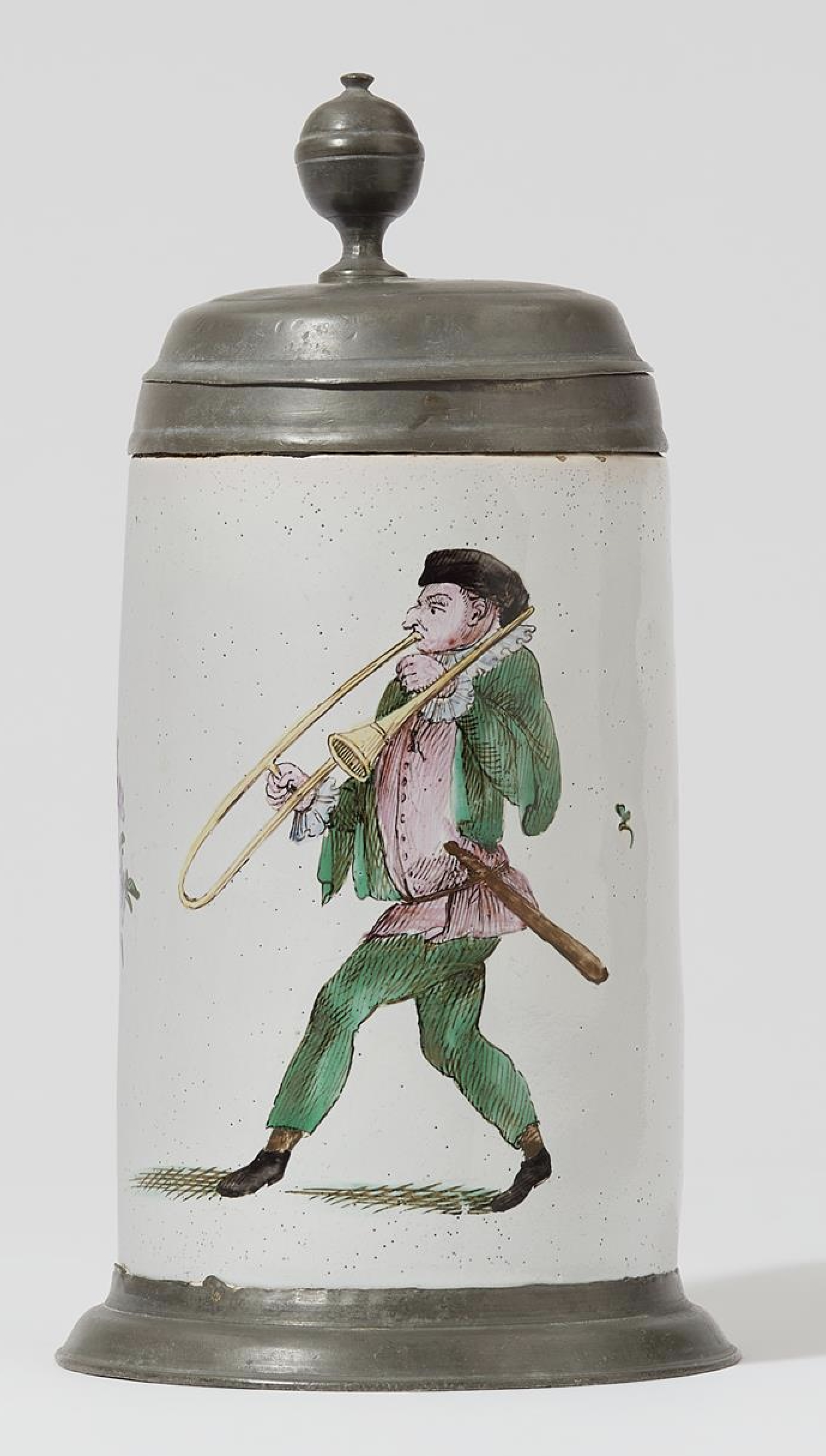

1804—Vienna, Austria: Antonio Salieri, teacher of Beethoven, Schubert, and Liszt, writes his Requiem in C minor. The piece, which calls for 3 trombones, is later performed at Salieri’s own funeral. Regarding Salieri’s use of trombone in the work, one commentator notes, “The bulk of the orchestration is for strings, but when the composer wanted to suggest solemnity, he used the trombones” (Chase 224).
1804—St. Petersburg, Russia: Boieldieu’s French opera, Ma tante Aurore, which includes trombones, is produced (Guion, Trombone 164).
 1804-1815—France: A military illustration labeled French Napoleonic Band depicts the foot grenadiers of the 1st Regimental Imperial Army Old Guard, including two trombonists marching with buccin-style instruments (trombones with dragon-head bells) (see facing detail; public domain) (Cassin-Scott and Fabb 15).
1804-1815—France: A military illustration labeled French Napoleonic Band depicts the foot grenadiers of the 1st Regimental Imperial Army Old Guard, including two trombonists marching with buccin-style instruments (trombones with dragon-head bells) (see facing detail; public domain) (Cassin-Scott and Fabb 15).
1805—Berlin, Germany: Where there is evidently a lack of skilled trombonists, the “Tuba Mirum” trombone solo of Mozart’s Requiem is performed on horn (Carse, Orchestra 40).
1805—Leipzig, Germany: Trombones are used for the first time in that city for Mozart’s Requiem. A reviewer in the publication Allgemeine musikalischeZeitung comments: “Earlier, one could not risk using these instruments, because Mozart wrote very difficult parts (sometimes unreasonably so), and we had no trombonists who could perform them reliably. But now a trombone section that can already be called excellent has been trained among the young men, who study instrumental music according to the improved arrangement of the town musicians, and showed themselves to advantage in this and other concert and theatrical productions (Guion, Trombone 156).
1805—Beethoven, Fidelio. Trombones are used in the overture and dungeon scene.
1805—Liverpool, England: A music festival includes the following trombonists: Mariotti, Zwingman, Flack (Guion, Trombone 148).
1805—London, England: Musicologist Charles Burney writes, “Tromboni and double-drums are now so frequently used at the opera, oratories, and in symphonies, that they are become a nuisance…” (Guion, Trombone 92).
1805—St. Petersburg, Russia: Boieldieu produces his French opera, La jeune femme colére, which includes trombones (Guion, Trombone 164).
1805—Netherlands: A watercolor labeled Batavian Republic and dated 1805 features a military trombonist playing a rear-facing trombone (see below image; public domain) (New York Public Library Digital Gallery).
1806—Michael Haydn dies before completing his Requiem in B-flat Major. The existing movements—an “Introit,” “Kryie,” and “Dies Irae” (partial)—require 3 trombones. The “Tuba mirum” portion of the “Dies Irae” features soprano and alto soloists with a trombone obbligato (Chase 205).
1806—France: An image depicting 7 French military musicians includes a soldier playing a rear-facing trombone (see below image; public domain) (New York Public Library Digital Gallery).
1806—Christian Friedrich Daniel Schubart writes, “This instrument is entirely ecclesiastical…This instrument has never been profaned throughout the millennia, but rather has always remained a heritage of God’s temple…In our days, however, they have been desecrated for the service of opera, and the trombone is no longer the property of God’s worship. It is also used now with great effect in the choruses of large operas…Not only church music has now been composed for trombone, but also concertos, sonatas, and solos, and these always have an admirable effect…But it is certain that the sound of the trombone is truly intended for religion and not at all for secular use” (Guion, Trombone 84-86).
1807—Swedish composer Joachim Eggert composes his Symphony No. 3, which includes trombones (Guion, Short History).
1807—Vienna, Austria: The Imperial Orchestra includes 2 trombones (Herbert, Trombone 333).
1807—John Marsh, in his Hints to Young Composers of Instrumental Music, explains that trombones are used more often than is indicated strictly by scores: “Composers seldom insert parts for them in their scores, but leave them to be added afterwards, as may be required, which can easily be done from the score by any composer or judge of composition.” He then complains, “The growing practice of over-straining the choruses, by trombones and double drums too forcibly beaten, what should occasionally produce an awful and grand effect, degenerates into continued noise and clatter.” (Guion, Trombone 88-89).
1807-08—Germany: Christoph and Cornelius Suhr, in their book on military uniforms in Hamburg (Abbildung der uniformen aller in Hamburg), depict musicians from the Dutch military in Hamburg from the years 1807-08. Included is a musician with a somewhat awkwardly-rendered rear-facing trombone (see below image; public domain).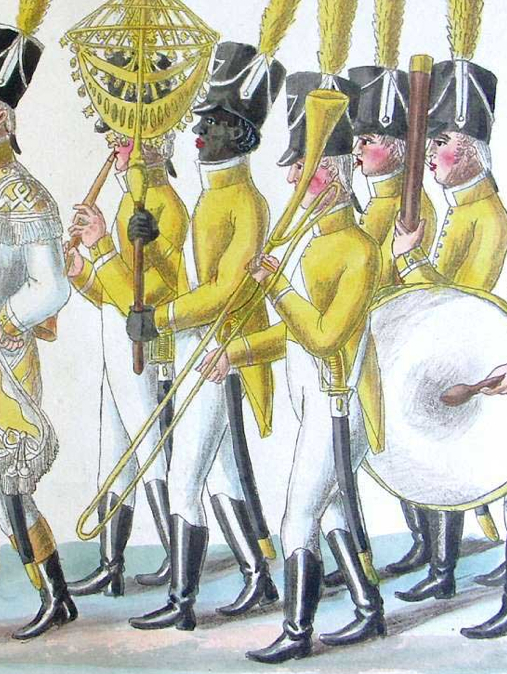
1808—Beethoven’s Symphony No. 6 calls for 2 trombones—in the storm and in the Peasants’ Thanksgiving.
1809—Beethoven’s Symphony No. 5 is the first orchestral work by a major composer to utilize trombones. It calls for 3 trombones—alto, tenor, and bass.
1810—Paris, France: A rendering of a military musician from the 1st Hussars depicts a trombone with a dragon-shaped bell (buccin) (see facing image; public domain).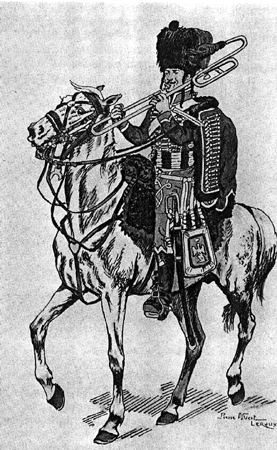
1810—Paris, France: The Opéra’s orchestra contains 3 trombones (Herbert, Trombone 333).
1810—Beethoven refers to 3 separate trombones—alto, tenor, and bass—in a letter to his publisher about trombone parts for his oratorio, Christ on the Mount of Olives. The original German reads “Alt, Tenor, Bass,” bracketed to the word “Posaunen” (Beethoven, Letters 95).
1810—Germany: The opera orchestra in Frankfurt am Main has 3 trombones (Guion, Trombone 267).
1810—Bologna, Italy: The San Petronio orchestra includes 1 trombone (Spitzer Ap D).
1810—Dresden, Germany: A charity concert utilizes 4 trombones (Spitzer Ap D).
1810-40—Strasbourg, France: An image by artist Boersch Thiébaut (1782-1861) that is part of set of figurines executed between 1810 and 1850 features musicians of the 14th Regiment, including 2 rear-facing trombones (see below image; public domain) (Paris, musée de l’Armée).
1811—Berlin, Germany: The Berlin Court Opera contains 3 trombones (Herbert, Trombone 333).
1811—Bonn, Germany: Joseph Frölich’s Vollständige theoretisch-practische Musikschule, is published. Frölich details many aspects of trombone playing not found in other methods or treatises up to this point, including holding the instrument, mouthpieces, and alternative slide positions (Dudgeon 194).
1811—Bonn, Germany: Joseph Fröhlich writes, “Its full, solemn tone…exalts it to an especially useful musical tool. Its full, sonorous tone enables the player to express all noble and effective sentiments for the exhibition and maintenance of the most solemn states of mind. Therefore, it was usually played in the olden days for the exaltation of singing in church music, and to be sure, must have greatly contributed to the inspiration of prayer and devotion… Just as a beautiful result of harmonies always has, and must have, so much effect on this instrument when it is played with soul and gentle articulation, so it is revolting and spoils all good impressions when the trombone is played with a wild and blaring tone, if the composer has not expressly indicated it” (Guion, Trombone 95).
1811—Berlin, Germany: The Königliche Kapelle includes trombones (Guion, Trombone 154).
 1811—An illustration of the Duke of Gloucester’s Band, an ensemble associated with the 3rd regiment of the Scots Guards, includes a trombone (see bottom left of facing image; public domain).
1811—An illustration of the Duke of Gloucester’s Band, an ensemble associated with the 3rd regiment of the Scots Guards, includes a trombone (see bottom left of facing image; public domain).
1812—Vienna, Austria: Tafelmusik for the emperor includes 2 trombones (Spitzer Ap D).
1812—Leipzig, Germany: The Gewandhaus orchestra includes 3 trombones (Spitzer Ap D).
1812—Linz, Austria: Beethoven, Drei Equali for 4 trombones.
1812-1816—St. Petersburg, Russia: An anonymous German instrument maker living in St. Petersburg manufactures several silver trombones that are presents of Tsar Alexander I to the trumpet corps of regiments that have displayed particular bravery in battle. They are used in ensembles known as “trumpet music,” comprised of numerous natural trumpets of various pitches and a trombone (Tarr, East Meets West 33).
1812-1816—Bethlehem, Pennsylvania: Records of musicians active in the Bethlehem Moravian congregation identify at least 16 trombonists, 5 of them youths (Carter, Trombone Ensembles of the Moravian).
1813—Paris, France: The orchestra of the Theatre des Verietes includes 1 trombone (Spitzer Ap D).
1813—Paris, France: The orchestra of the Opéra includes 3 trombones (Spitzer Ap D).
1813—An eyewitness German account of the Russian Cuirassier regiments’ music corps at the occupation of Paris observes, “The heavy cuirassier regiment with large horses had…its own music corps, [which was] not only beautiful and most effective, but also completely appropriate to and most characteristic of such a choir of soldiers. It consisted only of six trumpets and six trombones. The musical pieces were also completely as they should have been for their warlike destination in general and their character in particular, also as far as the nature and the most powerful effect of these very instruments were concerned…” (Tarr, East Meets West 34).
1813—Vienna, Austria: A set of three trombones by the workshop of Joseph Huschauer reveals instruments of three distinct lengths (Museum of Musical Instruments of the Galleria dell’Academia, Florence; see below image; photograph by author).
1813-16—Bohemia: The Prague Opera contains 3 trombones (Herbert, Trombone 333).
1814—Luigi Cherubini, who later becomes director of the Paris Conservatoire, writes a work for 5 brass instruments titled Pas redoubles et marches pour la Garde du Roi de Prusse. Scored for natural trumpet, 3 hand-horns, and serpent or trombone, it is conceived in the French Revolutionary military band tradition (Wallace, Brass Solo 240).
1814—Milan, Italy: La Scala orchestra includes 1 trombone (Herbert, Trombone 333).
c. 1815—Munich, Germany: Musik der Bürger-Garde der Haupt u. Residenz-Stadt München, a print by J.C. Hochwind, includes players of both traditional and rear-facing trombones (see detail and full image below; public domain) (Ryan 202).
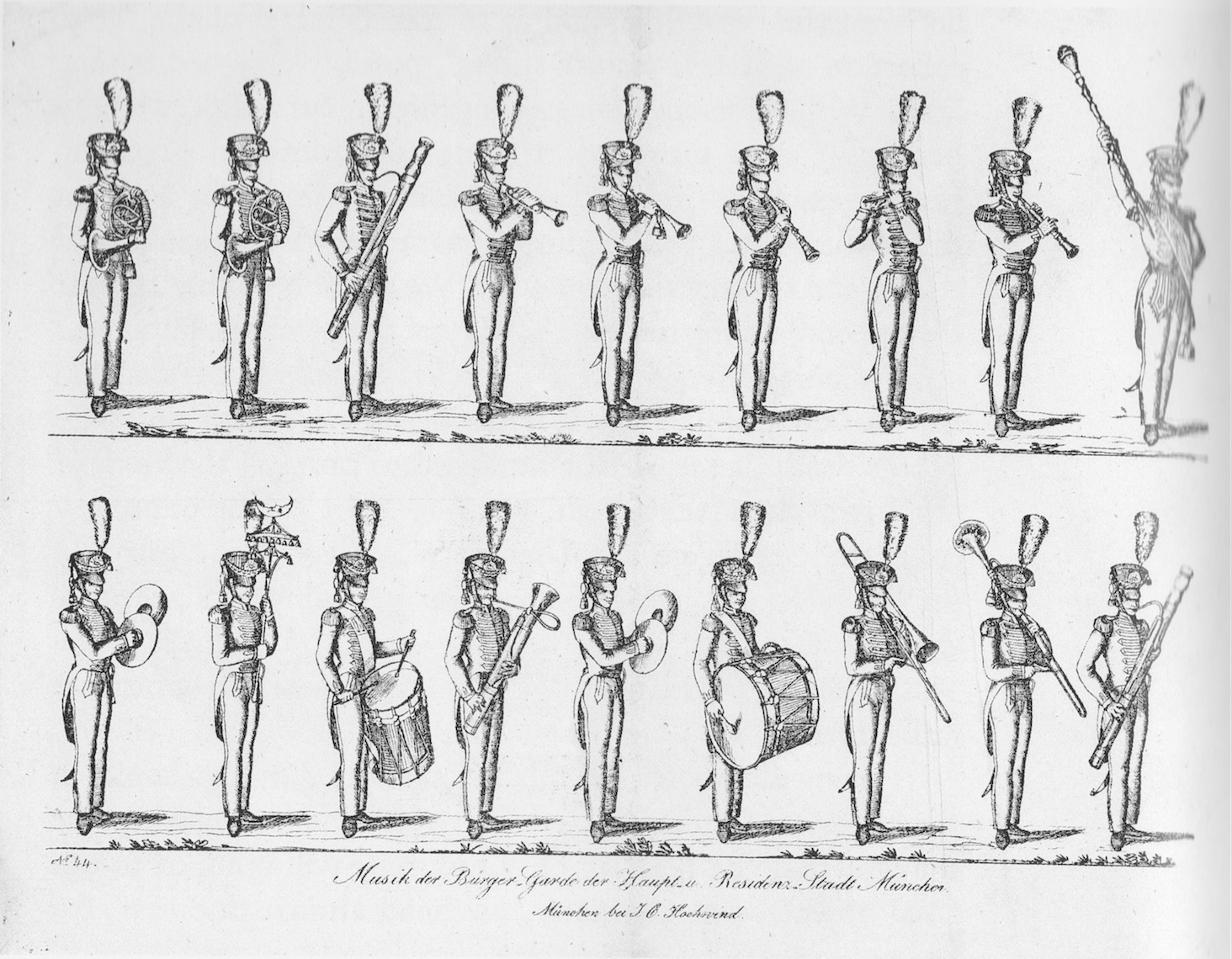
c. 1815—London, England: S. Potter’s method for keyed bugle, The Bugle Horn Major’s Companion, includes 12 brass quartet arrangements (“Two slow marches & ten Quick Steps”) for 2 keyed bugles, one natural bugle, and one trombone (Dudgeon, Keyed Bugle 156).
c. 1815—Bass trombones with double slides, pitched in F, are among the gifts from Tsar Alexander I (of Russia) to the trumpet corps of regiments that had displayed particular bravery in repelling Napoleon and in other campaigns. Bass trombone, apparently, is part of the regular Russian trumpet corps.
1815—London, England: The “Oratorio Concerts” in Covent Garden include 3 trombones (Herbert, Trombone 333).
1815—Berlin, Germany: Heinrich Stölzel develops the modern valve (on a horn). He takes out a patent jointly with Friedrich Blühmel for the valve in 1818 (Bate 146).
1815-1876—Leipzig, Germany: There are 34 solo trombone performances at the prestigious Gewandhaus, helping establish the trombone as a solo instrument in 19 century Germany. Other soloists at the Gewandhaus during these years include many of the top performers of the Romantic era; e.g., Niccolo Paganini, Johann Hummel, Felix Mendelssohn, Clara Wieck, and Franz Liszt.
1815—Leipzig, Germany: In April, trombonist Friedrich August Belcke appears as soloist with Gewandhaus Orchestra, marking the first solo performance by a trombonist at the Gewandhaus and the beginning of Belcke’s 30-year solo career. Belcke performs a new work by Carl Heinrich Meyer called Potpourri mit obligatur Bassposaune (now lost). A review of the performance in the Allgemeine musikalischeZeitung says, “Finally, Mr. Belcke, a young man of talent and considerable skill, astonished us with a potpourri for trombone with orchestral accompaniment, in a style which was for us completely new. The work [by] Mr. Meyer, likewise (from) Leipzig, was not only written with a complete knowledge of the instrument and skilled exploitation of all its principal qualities, but was also very well written as a piece of music in general; and, in spite of its great difficulty, the soloist played it with a precision, clarity and neatness—yes, even with a fine cantilena—such as we have never heard before from a trombonist” (Lewis, Gewandhaus).
1815—Leipzig, Germany: In November, Trombonist Friedrich August Belcke appears again as soloist at the Gewandhaus, premiering another composition by Carl Heinrich Meyer, the Fantasie für Bassposaune (now lost) (Lewis, Gewandhaus).
1816—The concept of the double slide is revived (see 1540) by Gottfried Weber and adopted by C. A. Moritz of Berlin, who constructs a B-flat contrabass to Wagner’s instructions for the first performances of The Ring (Gregory 94).
1816—Paris, France: Luigi Cherubini composes his Requiem in C Minor, which calls for 3 trombones. Commissioned by Louis XVIII to commemorate the deaths of Louis XVI and his wife, Marie Antoinette, it is first performed at the Crypt of St. Denis. Considered by some to be among Cherubini best works, it is the model that Beethoven said he would use if he ever composed a requiem. Although Beethoven, of course, never composes a requiem, the Cherubini’s requiem is performed at Beethoven’s funeral (Chase 192).
1817—Prussia: Prussian Jägr regimental bands have an instrumentation of 2 trombones, 3 horns, 2 keyed bugles, and 2 trumpets as early as 1817 (Dudgeon, Keyed Bugle 166).
1817—Bremen, Germany: The Bremen Town Orchestra contains a single trombone (Herbert, Trombone 333).
1817—London, England: The “Ancient Concerts” include 3 trombones (Herbert, Trombone 333).
1817—Gioacchino Rossini, La Gazza Ladra.
1817—Gottfried Weber designs a complete set of double-slide trombones. Made by Schott of Mainz, these instruments all have 9 slide positions instead of 7 (Carse, Musical 258).
1817—Paris, France: The Theatre Italien orchestra includes 2 trombones (Herbert, Trombone 333).
1817-1818—Bethlehem, Pennsylvania: Sources document a rivalry between 2 different Moravian trombone ensembles, an adult choir and a youth choir (Carter, Trombone Ensembles of the Moravian).
1818—London, England: There is 1 trombone in the King’s Theatre orchestra (Herbert, Trombone 333).
1818—Paris, France: Portugese composer João Bomtempo writes Messe de requiem consacrée a Cameos, which calls for 2 trombones and features a brass fanfare at the opening of the “Tuba mirum” (Chase 247). The “Tuba mirum” in the clip below begins at 2:16.
1818—London, England: The orchestra of the Covent Garden Theatre contains 1 trombone (Herbert, Trombone 333). Samuel Pritchard, who is also listed as player of the “bugle horn,” is trombonist in the orchestra (Carse, Orchestra 489).
1818—England: The famous “Besses o’ the Barn,” a brass and reed band, is formed and includes one trombone (Bate 142).
1818—England: The Prince Regent’s Band of George IV, said to be the finest band in Europe, is headquartered at the Pavilion at Brighton. It includes 4 trombones: soprano, alto, tenor, and bass (Carse, The Prince Regent’s Band).
1818—Naples, Italy: The orchestra of the Teatro San Carlo includes 3 trombones (Herbert, Trombone 333).
1818—Leipzig, Germany: Advertisement appears in the German publication Allgemeine Musikalische Zeitung, stating that Stölzel and Blümel have invented a trombone valve enabling trombonists to play all notes of the chromatic scale. However, according to Nemetz, the Viennese maker Riedl is actually the first to apply the valve system to the trombone (Carse, Musical 258).
1819—Spontini, Olympie. Brass band appears on stage in 3rd act. First use of brass instruments on stage in Paris Opera.
1819—Schubert’s incidental music to Rosamunde calls for trombones, who accompany a chorus of evil spirits and play in a ballet.
1820s—Stockholm, Sweden: Bernhard Crusell writes 10 military marches and dances for a brass ensemble consisting of keyed bugle, 3 horns, 2 natural trumpets, and trombone. This instrumentation, known as the Hornseptett, soon becomes standard in Swedish military music (Wallace, Brass Solo 241).
c. 1820—France: An etching titled The French Garrison, probably set in Normandy, depicts a group of French soldiers mingling with villagers. A fiddler and a regiment trombonist with a rear-facing instrument provide music for dancing while standing on a makeshift stage (see upper-right of below image; public domain) (Fromrich 24).
c. 1820—London, England: The Royal Artillery Band, which is comprised of 39 players, includes one alto trombone, tenor trombone, and bass trombone (Dudgeon, Keyed Bugle 29).
c. 1820–Paris, France: An anonymous illustration of a French military band includes two rear-facing trombones (see top row of below image; public domain) (Camus, Military Musicians).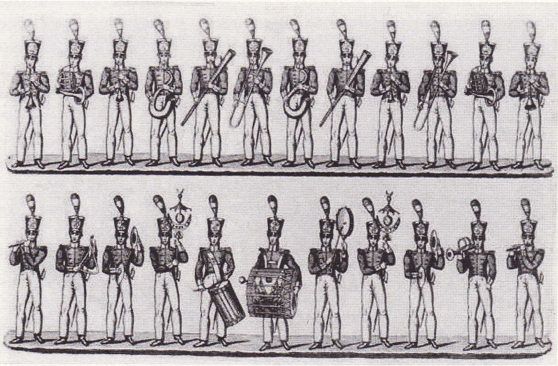
1820—Paris, France: The Opéra contains 3 trombones (Herbert, Trombone 333).
1820—Milan: A hand-colored engraving entitled Banda degli Ulani Francesi (Band of French Lancers) features a number of mounted musicians, including trombones (see below image; click to expand; public domain) (source: Oberlin Conservatory Library Special Collections).
1820—Gnadenhutten, Ohio: Records from the dedication of a Moravian church building reveal that after the proceedings of the dedication are read by the pastor, “Then we went with the sound of trombones and the singing of the verse, ‘God bless our going out,’ …two by two through the courtyard, and formed a circle on the street, facing the new church” (Hartzell 50).
1820—A hand-colored engraving, entitled Banda Militare, includes depictions of 2 rear-facing trombones (see below image; click to expand; public domain) (Oberlin Conservatory Special Collections).
1820—C.H. Meyer, Concertino for Bass Trombone.
1820-39—Rotterdam, Netherlands: A catchpenny print by T.C. Hoffers and A. van Alphen depicting various military instruments includes 2 rear-facing trombones, one with a dragon bell (see below detail; public domain) (Catchpenny Prints of the Dutch Royal Library).
1821—New York: The West Point Academy Band includes a single trombone (Mendoza da Arce 184).
1821-1843—Solo career of trombonist Carl Queisser (1800-1846). He appears as soloist 26 times in Leipzig’s prestigious Gewandhaus concerts during these years—more than many famous soloists such as Anton Rubenstein, Clara Schumann, Johann Hummel, and Franz Liszt (Lewis, Gewandhaus). His primary repertory includes the C. H. Meyer Concertino for Bass Trombone (1820), a transcription of the Carl Maria von Weber Horn Concertino (1826), and the Ferdinand David Concertino (1837). According to historian John Wallace, the trombone’s popularity in Leipzig wanes after Queisser’s death.
1821—George IV, King of England, Entering Dublin, a painting by William Turner, depicts a band of cavalry musicians, including trombones and serpents (see detail and full image below; public domain) (National Gallery of Ireland).
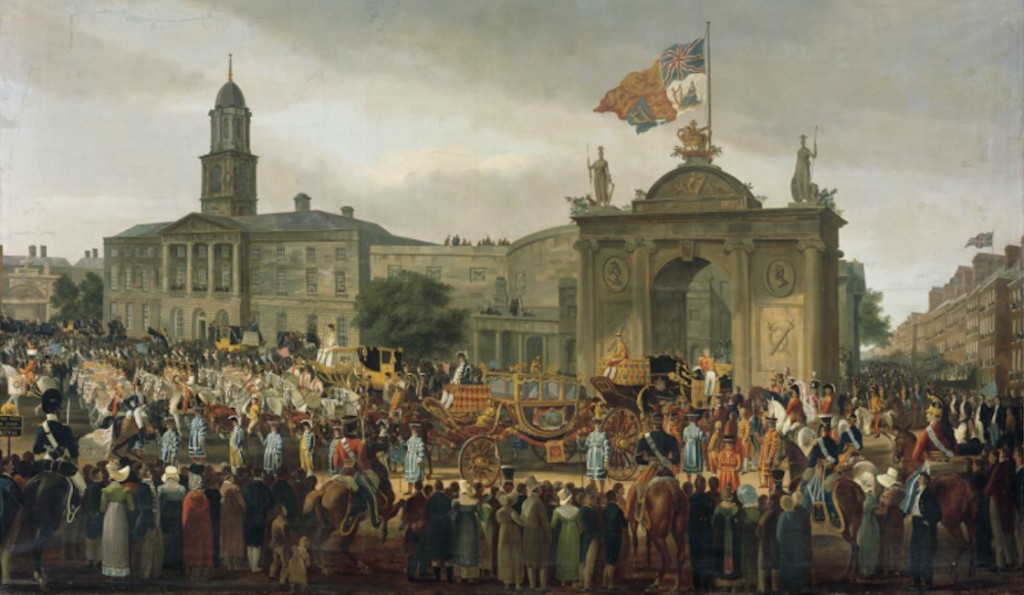
1821—Leipzig, Germany: Carl Queisser gives his debut solo performance with the Gewandhaus Orchestra. He performs the premier of the Carl Heinrich Meyer Concertino fur Bassposaune (Lewis, Gewandhaus).
1821—Frankfurt, Germany: The Frankfurt Opera orchestra includes 1 trombone (Herbert, Trombone 333).
1821—Vienna, Austria: The Vienna Court Opera orchestra includes 3 trombones (Herbert, Trombone 333).
 1821—Italy: A depiction of musicians from the Italian grenadiers includes a trombonist with a rear-facing instrument (see facing image; public domain) (Melegari 147).
1821—Italy: A depiction of musicians from the Italian grenadiers includes a trombonist with a rear-facing instrument (see facing image; public domain) (Melegari 147).
1822—Manchester, England: The Manchester Philharmonic includes 3 trombones (Herbert, Trombone 333).
1822—Philadelphia, Pennsylvania: The Musical Fund Society of Philadelphia performs Haydn’s Creation. There are no trombonists in Philadelphia, so 3 Moravian trombonists from Bethlehem, Pennsylvania are hired to play the parts (Guion, Trombone 122; Carter, Trombone Ensembles of the Moravian).
c. 1823—Vienna, Austria: A lithograph depicts a military band of the Hungarian LIR 52, marching on the glacis just outside the Vienna city wall. The depiction includes both a rear-facing trombone and a front-facing trombone (see detail below; public domain) (Brixel, Österreichs Militär Musik).
1823—Leipzig, Germany: Carl Queisser performs the Meyer Concertino again at the Gewandhaus. The review in the Allgemeine musikalischeZeitung says, “On February 13 the Concertino by Meyer was performed by Mr. Queisser…the beautiful music seemed to us not entirely suitable for the instrument…there were too many fast runs in the piece for the nature of the instrument” (Lewis, Gewandhaus).
1823—Munich, Germany: In response to a female clarinet player performing a concerto in Munich, a reviewer writes sarcastically, “Our modern belles are determined not to be excluded from exercising any department of art; all we now want is a female virtuoso on the bassoon and trombone, we believe the list will then be complete” (Stratton).
1823—Germany: The orchestra of the King of Prussia includes 2 trombones (Herbert, Trombone 333).
1823—Germany: The Darmstadt Court Opera includes 3 trombones (Herbert, Trombone 333).
1823—Nuremberg, Germany: The orchestra of the Grand Duke of Hesse-Cassel includes 3 trombones (Herbert, Trombone 333).
1824—Belgium: A pen and ink drawing of a Belgian military trombonist depicts a player in full military regalia with a rear-facing trombone (see below image; public domain) (New York Public Library Digital Gallery).
1824—Milan, Italy: Francesco Mirecki, a Polish musician active in Italy, mentions trombone in his treatise, the earliest known Italian orchestration treatise. He considers bass trombone a useful alternative to serpent as the effective bass of the brass family (Meucci).
1824—Vienna, Austria: Ludwig van Beethoven composes Symphony No. 9, which includes prominent use of alto, tenor, and bass trombone. As historian Thurston Dart notes, “Few concert-goers probably realize that of all the instruments they hear in Beethoven’s ninth symphony, for instance, the only ones whose sounds have not changed since the symphony was first performed in 1824 are the kettle-drum, the triangle, and the trombone. All the others have been transformed, some more and some less, and even if the symphony is played with the same number of instruments and voices that were used in 1824, the resultant sound will be quite different in quality” (Dart, Interpretation 34).
1824—England: One of the earliest valve patents for brass specifically mentions trombone (Bate 148).
c. 1825—France: Pellerin, publisher of French popular prints, publishes a print titled Musique d’Infanterie Francaise, which includes a rear-facing trombone (upper-right). Other low brass instruments of interest in the image include a serpent next to the trombone and an ophicleide on left side of the next row (see below detail; public domain) (Museum of Civilization in Europe and the Mediterranean).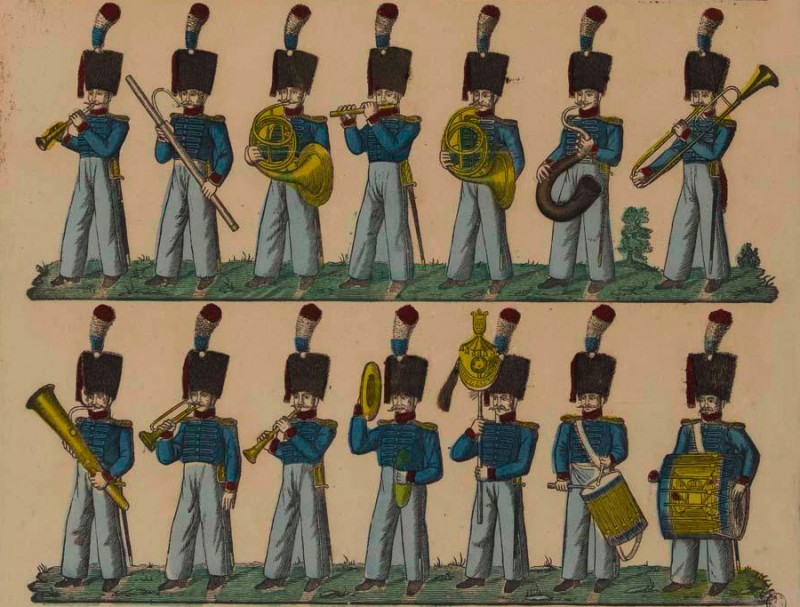
1825—Belgium: Sir George Smart, a British traveler, observes, “We heard a very good military horse band which was all trumpets, bugles and tromboni” (Smart 66).
1825—Darmstadt, Germany: Sir George Smart, a British traveler, hears the Darmstadt opera and very briefly mentions the trombones: “Three tromboni (these had not much to do and were not conspicuous)” (Cox 77).
1825—Stuttgart, Germany: Sir George Smart, a British traveler, attends a church service in Stuttgart, where he is impressed with the trombones: “After breakfast I went into what I believed was a Protestant church….A few men singers were singing a tune exactly like our psalm tunes, accompanied by a soprano and three tromboni, with the organ—the effect was grand—they were dressed in black gowns and played excellently” (Cox 82).
1825—Munich, Germany: Sir George Smart, a British traveler, hears a military band that includes trombones: “I was delighted with the military band when they were mounting guard at twelve o’clock at the palace, they played several pieces which were new to me. The band seemed about forty strong with four trombones, etc., but I have not yet heard a good sounding trumpet (Cox 84).
1825—Munich, Germany: Sir George Smart, a British traveler, hears a performance of Weber’s Der Freischütz in Munich: “The tromboni were good but I have not yet heard a trumpet equal to Harper” (Cox 90).
1825—Dresden, Germany: Sir George Smart, a British traveler, attends a performance of Weber’s Euryanthe, noting the makeup of the orchestra: “The strength of the Dresden theatre band is as follows: Five first violins, five second violins, two viole, two ‘cellos, two basses, two of each wind instrument—the flutes taking the piccolo—four horns and three tromboni.” Smart also observes the specific layout of the orchestra: “All the strings were on the right and all the wind instruments on the left of the conductor, who beat time with a roll at a square piano-forte. The tromboni were one behind the other, each in the centre of the oboe desks” (Cox 140).
1825—Dresden, Germany: At the monument of the celebrated French general Moreau, just outside of Dresden, Sir George Smart witnesses a military band: “We saw the guard mounted between eleven and twelve o’clock, there were plenty of officers but not many men. The band numbered twenty-two and was good, but nothing extraordinary. There were three tromboni and two bassoons. Several of the marches and airs were in the minor and one of them was very chromatic and ineffective” (Cox 147).
1825—Berlin, Germany: Sir George Smart, a British traveler, attends the Berlin Opera and records that the orchestra includes three trombones (Smart 168). Of a performance of Spohr’s Jessonda, he specifically notes: “The wind instruments were so much out of tune in the overture that the effect was ruined, the rest however was very good. The playing of the tromboni in one of the songs was beyond all praise” (Cox 175).
1825—Hanover, Germany: Sir George Smart, a British traveler, attends a parade, where he hears several military bands that include trombone: “There was a mixture of bands on the parade, namely the guards band in white, the artillery in blue and the rifle band in a sort of dark green. Their instruments were chiefly bugles and trombones, besides drums and fifes, altogether they numbered about one hundred and fifty. I did not hear them play together” (Cox 203).
1825—Schubert’s Symphony No. 9 (“The Great”) is probably the earliest orchestral work to use trombones for primary melodic material and on equal terms with the other winds of the orchestra (Wills, Orchestra 160).
1825—Dresden, Germany: The Dresden Court Opera includes 3 trombones (Herbert, Trombone 333).
1825—Berlin, Germany: The Berlin Opera includes 3 trombones (Herbert, Trombone 333).
1825—Germany: The Darmstadt Court Opera contains 3 trombones (Herbert, Trombone 334).
1825—Dresden, Germany: The Hoftheater includes 3 trombones (Herbert, Trombone 333).
1825—London, England: The Covent Garden Theatre includes 1 trombone (Herbert, Trombone 333).
1825—Milan, Italy: La Scala orchestra includes 3 trombones (in contrast to 1 in 1814) (Herbert, Trombone 334).
1825—Vienna, Austria: Funeral services are held for Antonio Salieri, teacher of Beethoven, Schubert, and Liszt. Music at the services consists of Salieri’s own Requiem in C minor, originally composed in 1804, which requires 3 trombones. Regarding Salieri’s use of trombone in the piece, one commentator notes, “The bulk of the orchestration is for strings, but when the composer wanted to suggest solemnity, he used the trombones” (Chase 224).
1825—Dresden, Germany: Carl Queisser performs the Meyer Concertino again at the Gewandhaus. The review in the Allgemeine musikalischeZeitung says, “Mr. Queisser performed very favorably with regard to sound and execution,” while mentioning a separate performance, in which “Mr. Queisser delighted us in a still more beautiful and masterly way in a benefit performance for Mr. Hoch in the theater” (Lewis, Gewandhaus).
1825—New York: The brass section of the Independent Band consists of horns, trumpets, trombones, and serpent (Mendoza da Arce 185).
c. 1825-1830—Tuning slide at end of u-bend of bell pipe, water key at lower end of slide begin appearing on trombones (Carse, Musical 258).


